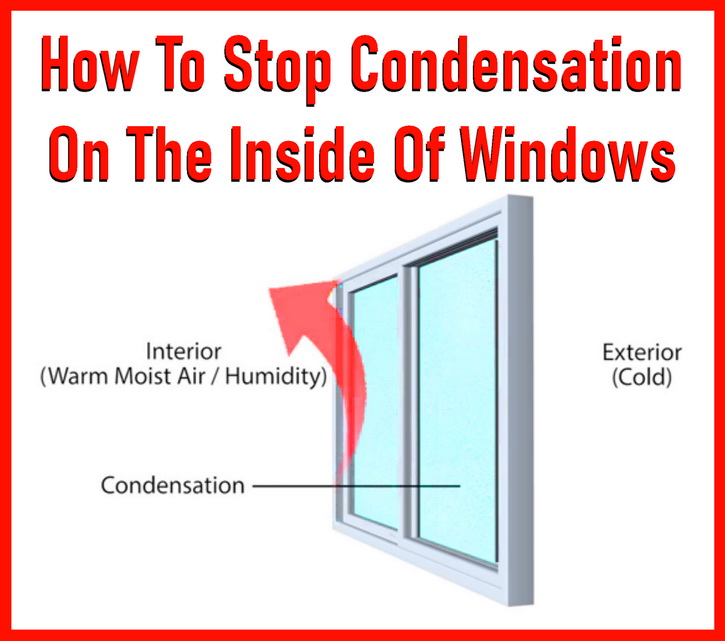Condensation on the inside of windows is a common problem for those who live in high summer humidity or colder climates. To prevent foggy or wet windows, try these steps that will help prevent condensation from forming on your inside windows.
 Stop Condensation On The Inside Of Windows
Stop Condensation On The Inside Of Windows
Interior condensation can form on your inside windows because the surface temperature of the window is below the dew point temperature of the air in your home. Lowering the amount of water vapor or moisture in the air inside your home will lower the dew point temperature and prevent condensation from forming on your inside windows.
Moisture always condenses on the warm side of the glass. Since the inside glass is warmer with cold weather outside, the moisture forms.
What can cause condensation to form on my inside windows?
- Bad or faulty seal around the window
- Not using bathroom vents when showering
- Kitchen range hood not being used when cooking
- Using the washer and dryer too often and possible venting issues
- Opening the front door too often when colder temps outside
- Heavy drapes or blinds can increase moisture/condensation
- Not using a dehumidifier in your home
- Improper home insulation issues
How to Reduce Interior Condensation on Your Windows
Best ways to prevent moisture on inside windows?
Check for seal leaks around your windows – Repair or replace faulty window seals as a faulty or badly installed window seal can be the cause of the windows getting condensation on the inside.
Ventilate your home by regularly running the air vents when cooking – Using the kitchen vent hood that exhausts to the outside will help to keep moisture down and keep condensation from forming on the windows.
Use the bathroom vent when showering or bathing – Taking a shower can create lots of steam and water vapors in the air, by using the bathroom air vent (with 100 CFM or more) can completely remove any of the water in the air and help stop condensation from forming. Letting the bathroom air vent run for an hour or so after showering will remove most moisture and help the windows collect less condensation.
Air out damp clothing outside to avoid moisture buildup in home – Any wet clothing that you may air dry in the laundry room can create moisture in the air, try using the dryer minimally or if possible air dry your clothing outside. Also, check to be sure the dryer is venting to the outside properly and no blockage has occurred as this will add more moist air into your home.
Do not open the doors to the outside excessively – When a door is opened (during cold weather months) it lets in cold moist air and this causes extra moisture in your home which adds more of a chance that your windows will get foggy with condensation.
Drapes and blinds can increase moisture – Try to increase the air movement or circulation on the window surface as heavy duty drapes or blinds may increase the moisture and condensation as it can trap the moisture between the drape and the window.
Reduce humidity levels in the home by running a dehumidifier – A dehumidifier reduces the moisture in your home and thus preventing condensation on your windows.
Use an anti-fog product on the inside window – This product is used on automobile windows such as Rain-X water repellent, this product can repel water/moisture from forming on the windows and bathroom mirrors.
Use a box fan on low to blow moist air away from the windows – Circulating the air can assist with moisture not building up on your inside windows.
Wiping down surfaces to remove moisture – Wet areas of your home such as a wet countertop or freshly mopped floor can create even more moisture in the air, wipe up any excess water ASAP to avoid adding any more moisture to the air.
Run the central air conditioning vent fan when it is humid outside – If possible, or reasonable, use the fan on your central AC or heater to keep the air circulating in the home to prevent moisture from accumulating.
Home may have bad insulation – If your home has poor insulation, this can let more moisture into the home and cause the windows fogging up issue.
If your home has a finished attic with insulation, make sure that it is dry and properly ventilated so that moisture does not accumulate and cause condensation. Other anti moisture steps include adding the proper insulation to heating ducts or pipes where hot air may be leaking into colder areas. Also do not store any items next to interior or exterior walls where they may block the ventilation and cause moisture by trapping humidity. Be sure to also keep water sources away from your homes outside walls as this may turn into problems with mold that can contribute to extra moisture.
Have questions about how to keep your inside windows free of condensation? Please leave a comment below and someone can assist you.



Leave a Reply